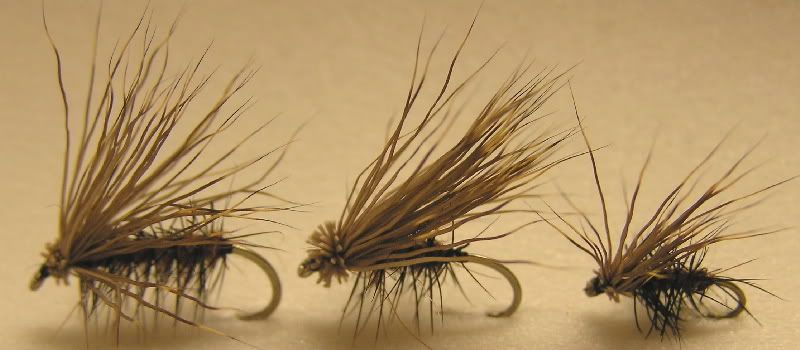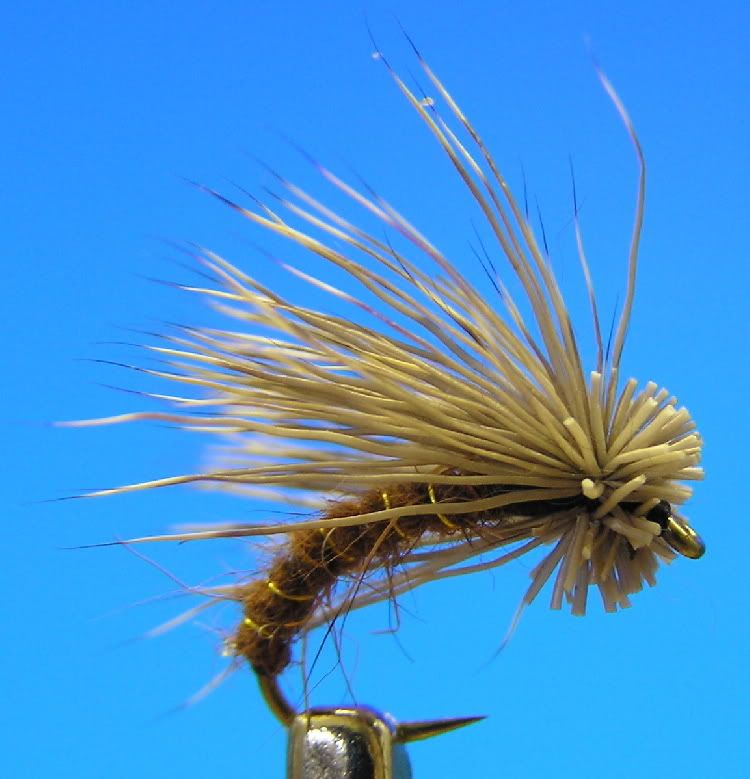I finally took the plunge and started tying about 2 months ago, and have managed to do up some passable flies. Nymphs, wooly buggers, no problem. But then I thought I’d tie some deer hair caddis on a #12 hook and work my way down to smaller sizes. I’m not sure what I’m doing wrong, but they just don’t look the way I want them. I keep looking and second guessing - The deer hair doesn’t want to stay on top of the hook, and it also appears I have some with too much and some that look a bit threadbare! Any suggestions?
Fishin Bill,
When tying with elk or deer hair it’s always a good idea to comb out the short hair (I use an old tooth brush). I would also suggest you use a hair stacker, if you aren’t already. It’s a good way to make sure that all of the hair is even (probably some of the reason why some of your flys seem to have too much hair and others not enough. When tying the fly, hold the hair stack on top and make two loose wraps with your thread. On the third wrap pull tighter, but make sure you are pulling up not down on the thread, this should keep the thread from breaking. On subsequent wraps tighted more, always pulling tighter up not down. Trim the hair to make a head and whip finish (I actually only use a couple of half hitches with head cement) This technique will keep the hair wing from moving.
If it seems like you still have too much hair on the fly, you probably do.
Bill,
Sometimes what “seems” an easy tie isn’t so, until some simple needs are met.
In this case a few things come to mind. You need to keep the word “sparse” in mind. Inother words, “less is more” when it comes to tying. I still have trouble so don’t feel alone.
Briefly then, be certain when you totally wrap your hookshank (you do, right?) to give a less slippery base for mounting materials, that you are sure to keep the wraps tight…tight…so things don’t slip from that standpoint.
Many thing to consider but perhaps a guru to take some better advice from is found within this link. I think many will agree on Hans W.'s skills…
http://www.danica.com/flytier/hweilenmann/cdcelk.htm
Study them. Good luck and keep this fun. It’s a learning curve for everyone.
Jeremy.
Bill, PA angler has some good advise. I had problems with the hair spinning too. I learned to control it by holding on to the hair and after a few loose wraps tightening by pulling up. Then I take a wrap through about a third of the hair on front, then another wrap through the next third, then once or twice around the hook and then back to the original wrap. A couple more wraps there and a whip finish or half-hitch, snip and glue.
If you have a hair stacker use it after combing out the hair. If you don’t have one you can make a temporary by cutting a small medicine bottle in half lengthways and put the hair in it tip down. Keeping it at an angle tap it lightly on the tabletop to stack the hair. Once it’s cleaned and stacked it’s a lot easier to work with.
As on the site Jeremy sent, make a big head. That keeps the thread from getting loose and fish like it. Good luck with it and keep on trying and tying.
I’ve learned that fish feel sorry for us and take our bad flies out of sympathy. Jim
Tying with hair can be frustrating, it took me a lot of practice before I started to feel like I could master this material. Keep at it, the results are worth the effort. Here are some tips gleaned from my experiences…
-
Not all hair is the same. There are many types of textures which each have a fly tying application. Do some research and learn what to look for to match your material to it’s application. Some hair is best for spinning, some is best for tails or wings, some is best for flaring, etc. The ‘Fly Tier’s Bench side Reference’ has an excellent chapter on hair and how to use it, perhaps your local library has a copy. There are also lots of good resources on the web. Try a different patch of deer hair and see how that works.
-
Find hair that is just right for a caddis pattern is difficult. it needs just the right amount of hollow shaft vs solid shaft to get the perfect flare. If there is too much hollow the hair flares too much and tends to spin when thread pressure is applied. Hair that is too solid can be slippery and very hard to bind the the hook also it may not flare enough to give a good profile.
One trick that has worked for me is to tie the hair in backwards, ie. with the tips towards the hook eye and the butts towards the hook bend. This puts the more solid tips at the tie in point for a strong attachment and the hollow more buoyant butt ends near the heavy part of the hook. It also has the advantage that you can trim the butt end to size after the hair is tied in place.
-
As your tying skills improve you will be able to handle larger clumps of hair. Until then, work with smaller bundles that you can easily control, use a bundle that is more the size of a wooden matchstick than a pencil. As long as you don’t use too many wraps (too bulky!) you can build the wing up in several layers. It’s much easier to control the spinning and thread pressure with a smaller bundle. Don’t be afraid to add a drop of glue to the tie in point in order to lock each layer in place. A really well tied hair wing doesn’t need the glue but it’s easy insurance. The most common novice mistake I see is using too much hair, the Elk Hair Caddis (or Deer Hair caddis) can be tied fairly sparse. Too much hair and the bug will look like it needs a hair cut after a few casts.
-
Here is a simple technique that will help keep the hair bundle on the top of the hook shank. Instead of tying the hair on with the standard overhand wrap, use a figure 8 wrap. Hold the hair bundle parallel to the hook shank in the normal tie in position, with the thread on top of the hook shank. Now pull the thread up along the far side of the hair bundle, over the top, down the near side and back over the hook shank (ie. make a loose full circle wrap around the hair bundle in the opposite direction of your normal tying wrap.) This makes a ‘figure 8’ out of the thread, the top of the 8 holds the hair, the bottom of the 8 goes around the hook shank. Now pinch the bundle tightly and pull straight down on the thread to tighten the bundle and flare the hair, add several more firm wraps to secure bundle and tie off. This technique gathers the hair into a tight bundle and helps prevent it from spinning around the shank.
Follow the tip of Jeremy,
I tie my caddis flies and other flies at the same way as desribed by Hans Weilemann.
In the past I had also problems with tying hair.
Here are a few examples of flies which were tied with the “H. Weileman method”
I’ve cought a lot with this patterns.


Wow! Talk about getting your problems solved! It works! For one thing, I was taking a couple of wraps around the hair, but too tightly. And I don’t know why, but I failed to cover the entire hook, so the hair was trying to spin (Okay for some other applications, but not in this case). The one thing I was doing right was removing the soft underhair, but using the stacker does help get everything lined up and straight. When I began visualizing an amount of hair about the size of a wooden matchstick, it all fell into place! I just have to remember that the matchstick is smaller for a #16 hook than for a #12…
So now I’m looking at 3 flies that all pretty much look alike, and wondering if I can wait more than 3 days to try them out.
Thanks so much for all the help! Now does anyone know anything about a 1040 form? Looks like today is doomsday, but I’m ready to fish!
Good Thread and thanks for the tip above. I have been struggling with Madam X’s and getting things to stay. I have one early tie of the Madam I call the Amityville Horror because the head likes to spin around! LOL. Hopefully the fish will have some sympathy as mentioned above. This has given me a couple of good ideas to improve!
Or as Ebeneezer Scrooge and the IRS folks like to say “Harvest Time”.LOL
On some flies I also have problem with the head spinning.
To solve this I put a layer of head cement or nail polish on top of the thread-wrapped hook. I let this dry before finishing the tie.
Ed
Fishing Bill’s former problem is like so many in fly tying, you are missing just one small piece of information and it ruins everything. Fix that one flaw and BINGO! When I first tried to use fur dubbing many years ago, my fly bodies looked like they had been tarred and feathered no matter what I did. I went to our local fly shop and complained about my problem and one of the hangers-on simply said “pinch the snot out of the fur when you roll it on the thread.” Problem solved. One small piece of information fixed everything. 8T ![]()
Yep. It’s a little like that word “sparse”.
I don’t know why I still refuse to “half” most everything (dubbing especially) yet wonder why the flies look so cluttered!
It hurts to find/admit you’re really that stubborn…:roll:
I’ll fix it. I’m getting too d**m old not to!
Jeremy
Hi,
For me it’'s the hackle on spiders. If I’ve not been tying them for awhile it takes me ages to get back to just one turn of hackle. And then I wonder why they look too front heavy? When I finally can convince myself to do it the way my brain knows it should even though my head tells me to wrap twice, they start to look better. After tying them for years, I’ve only recently tried stripping one side (and that really improves the look of some of the larger fibred hackles, like hen pheasant or grouse). I’ve read this tip over and over but my head tells me I’m wasting good material.
Of course, in the end, the fish have taken flies tied every which way, so both my head and my brain need to listen to the fish more than the fisherman!
- Jeff
Which is why some of us have signatures …
Try taking one wrap of thread around just the hair to bundle it together then tie it down with tight wraps of thread. If the wing sticks up too much make some looser wraps towards the rear until the hair lays down at the angle you want it too. The only disadvantage with wrapping the hair first is that the wing may not hang down on each side as far as you would like, but on small flies, especially Al Campbell’s Too Simple Caddis it works for me.
Good Luck, Tight Lines,
John